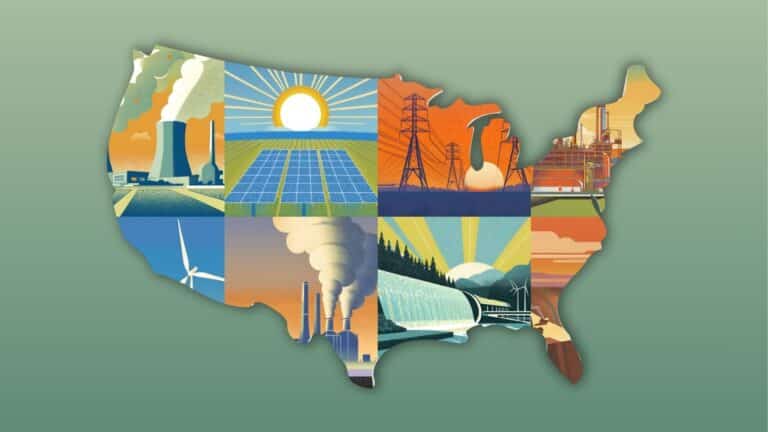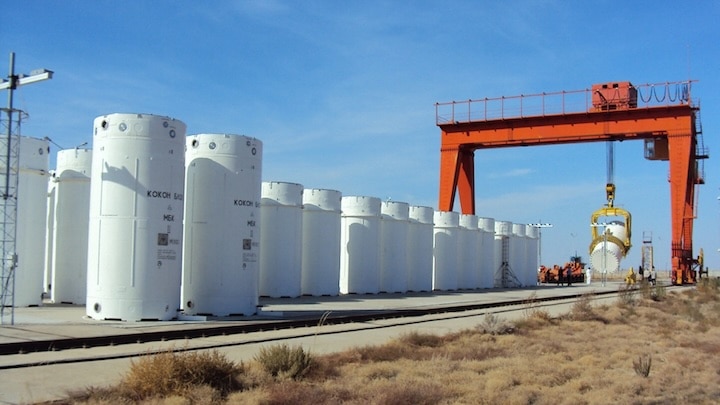Experts: What do Trump’s tariffs mean for global climate action?
The Trump administration has imposed tariffs on all imports from China, Mexico and Canada, as well as on steel, aluminium and cars from around the world
Current Access Level “I” – ID Only: CUID holders, alumni, and approved guests only
Q&A by Edward Fishman • November 30, 2022
After months of debate and preparation, the United States and other members of the G7 will impose a price cap on Russian crude oil on December 5. They plan to follow up with price caps on Russian oil products on February 5 of next year. The crude price cap marks the first major attempt by the US and its allies to cut Russia’s oil revenues, which have remained sky-high throughout Russia’s war against Ukraine.
In this first installment of a two-part Q&A on the price cap, Edward Fishman, a senior research scholar at the Center on Global Energy Policy, answers questions about the policy and how it is intended to work in practice.
The price cap on Russian oil is a policy backed by the G7 designed to curb Moscow’s oil revenues. Since Russia launched its invasion of Ukraine in February, the G7 has imposed a wide array of sanctions on Russia, freezing hundreds of billions of dollars in assets held by the Central Bank of Russia, severing many of the country’s largest banks from the global financial system, and cutting technology exports to its military-industrial complex. The sanctions have been impactful, throwing the Russian economy into a steep recession—the IMF projects Russia’s economy will contract 3.4 percent this year and 2.3 percent next year.[1] But up until now, the sanctions have largely spared the lifeblood of Russia’s economy: oil.
The price cap will change that. While the policy has often been described by some as a “buyers’ cartel,” that’s not quite right.[2] The United States imposed an embargo on Russian oil imports back in March, and the rest of the G7 will largely end oil purchases from Russia by December 5.[3] It would be impossible for the G7 to form a “buyers’ cartel” when they’re buying hardly any Russian oil.
A more accurate characterization of the price cap is that it is a “service providers’ cartel.” The G7 will allow companies in its jurisdiction to provide services in support of Russia’s oil sales only if the oil is sold below a price set by the G7. These services include trading, commodities brokering, financing, shipping, insurance, flagging, and customs brokering. Think of it like a carpool lane on a highway, which drivers can use only so long as they fulfill certain conditions. If Russia and its oil customers transact for a price below the cap, they can use the “G7 services lane;” if they transact for a price that exceeds the cap, they have to find another route. Of course, they can transact for a price that exceeds the cap, lie about it, and try to use the G7 services lane anyway, but doing so would risk penalties from the United States and other members of the G7. Such a deceptive scheme would be difficult to maintain at any meaningful scale for long.
The most important goal of the policy is to reduce Russia’s oil revenues. Throughout Putin’s brutal war, Russia has raked in roughly $20 billion each month selling oil.[4] This has helped shield Russia’s economy from the worst impacts of sanctions. But the policy has two additional goals, as spelled out by the US Treasury Department: to maintain a reliable supply of Russian oil to the global market and to reduce upward pressure on energy prices.[5] In essence, the policy intends to cut Russia’s oil revenues without squeezing global oil supplies and increasing prices. Spiking energy prices would not only be bad for consumers and businesses around the world, it could also perversely help Putin earn more money selling less oil.
The vast majority of seaborne Russian oil shipments rely on services provided by companies based in the G7, regardless of their final destination. Over half of all seaborne Russian oil is transported on Greek vessels, and around 95 percent is insured through the London-based International Group of P&I Clubs.[6] This is not unique to Russia—Greek vessels account for some 30 percent of the world’s total oil tanker fleet by tonnage, and the International Group of P&I Clubs dominates the global tanker insurance market.[7] If it cannot use G7-based services, Russia probably will not have access to enough of its own tankers (or tankers based in friendly countries) to continue shipping seaborne crude oil at current levels, roughly 3.5 million barrels per day.[8] As a result, the G7 believes that services represent a real chokepoint that it can leverage against Russia.
When the EU adopted its sixth Russia sanctions package in June, which included the EU embargo as well as a blanket ban on services, fears emerged in Washington that the result could be a significant reduction in Russian oil volumes on global markets, crunching supply and raising prices.[9] The United States, led by Treasury Secretary Janet Yellen, pushed hard for the price cap to allow for continued G7 services while still putting pressure on Putin’s oil revenues.[10] It was a way, Washington hoped, for the West to have its cake and eat it too by cutting the flow of petrodollars to Russia without spiking world oil prices.
Ever since the price cap policy entered public discussion earlier this year, a major criticism has been that service providers rarely have access to reliable price information, so compliance will be challenging. On November 22, the Treasury Department attempted to clear that up by publishing detailed guidance for service providers.[11] The guidance divides service providers into three tiers. Tier 1 includes companies that enjoy regular access to price information, such as commodities brokers and traders. Tier 2 includes actors that sometimes enjoy access to price information, such as customs brokers and vessel agents. Tier 3 includes actors that do not typically have access to price information, such as insurance providers and ship owners.
Naturally, the compliance burden falls most heavily on Tier 1—commodities brokers and traders. These actors must retain invoices, contracts, receipts, and other documentation indicating the price of oil cargoes, and provide them to actors in Tiers 2 and 3 along with signed attestations that relevant oil cargoes were purchased for a price below the cap. While this is not explicitly spelled out in the guidance, refineries in places like China and India will also be treated like Tier 1 actors. If they want to receive services from G7 entities in Tiers 2 or 3, they must provide price documentation and signed attestations indicating that they purchased the Russian oil cargo for a price below the cap. If a Tier 1 actor signs a fraudulent attestation or sends a kickback to Russia after making a nominally compliant purchase, they could be subject to penalties by the United States.
Compared with Tier 1 companies, actors in Tiers 2 and 3 have a relatively light compliance burden. So long as they secure attestations from actors in Tier 1 that an oil cargo was purchased below the cap, they can provide services in support of the transaction. Insurers have it the easiest: they are merely expected to include sanctions exclusion clauses in their policies and contracts, indicating that coverage is voided for oil cargoes that violate sanctions—a practice that is already common.
The Treasury Department has taken pains to make compliance straightforward, the rationale being that more often than not companies over-comply with US sanctions. The US government wants Russian oil to reach global markets; it just wants those barrels to be sold below the price cap. If compliance were too complicated, it’s likely key service providers would simply determine that dealing with Russian oil is not worth the risk, leading to substantial volumes of Russian oil coming off global markets.
Most affected service providers are not American but rather European companies. After all, it is largely Greek tankers and British insurers facilitating Russia’s oil exports. It’s reasonable to ask, therefore, what Washington’s role is in the matter.
The United States will play the central role in the price cap. In some instances, that’s because global banks that rely on the US financial system will serve as intermediaries in transactions for Russian oil. More broadly, Washington will play an outsized role because most major companies comply with US sanctions regulations regardless of where they are headquartered. In the last decade, US law enforcement agencies have built a formidable track record of sanctions enforcement, including hitting the French bank BNP Paribas with a $9 billion fine in 2014 for various sanctions violations.[12] Conversely, EU governments have no track record of aggressive sanctions enforcement, so EU-based companies will likely look to Washington to set the terms of enforcement for the price cap.
[1] “Russian Federation: At A Glance,” International Monetary Fund, accessed November 28, 2022, https://www.imf.org/en/Countries/RUS.
[2] David Lawder and Christian Kraemer, “G7 ministers forge ahead with Russian oil price cap, details thin,” Reuters, September 2, 2022, https://www.reuters.com/business/energy/g7-finance-chiefs-seen-advancing-russian-oil-price-cap-plan-2022-09-02/.
[3] “Fact Sheet: United States Bans Imports of Russian Oil, Liquefied Natural Gas, and Coal,” The White House, March 8, 2022, https://www.whitehouse.gov/briefing-room/statements-releases/2022/03/08/fact-sheet-united-states-bans-imports-of-russian-oil-liquefied-natural-gas-and-coal/.
[4] “Russia Earns Less Despite Higher August Oil Flows, IEA Says,” Bloomberg, September 14, 2022, https://www.bloomberg.com/news/articles/2022-09-14/russia-earns-less-despite-higher-oil-flows-in-august-iea-says.
[5] “Preliminary Guidance on Implementation of a Maritime Services Policy and Related Price Exception for Seaborne Russian Oil,” US Department of the Treasury, September 9, 2022, https://home.treasury.gov/system/files/126/cap_guidance_20220909.pdf.
[6] Michelle Wiese Bockmann, “Greeks shipping half of Russian crude,” Lloyd’s List, September 6, 2022, https://lloydslist.maritimeintelligence.informa.com/LL1142145/Greeks-shipping-half-of-Russian-crude#:~:text=HALF%20of%20all%20tankers%20lifting,seaborne%20crude%20from%20December%205https://www.bloomberg.com/news/articles/2022-05-04/eu-aims-to-target-russia-s-global-oil-sales-with-insurance-ban?sref=FSjtyMb8.
[7] Investigate Europe and Reporters United, “The European Shipping Giants Plying Putin’s Fossil-Fuels Trade,” EUobserver, September 29, 2022, https://euobserver.com/ukraine/156153.
[8] Noah Browning and Julia Payne, “Explainer: Russia’s Tanker Fleet Too Small to Bypass Oil Price Cap,” Reuters, November 23, 2022, https://www.reuters.com/markets/commodities/russias-tanker-fleet-too-small-bypass-oil-price-cap-2022-11-23/.
[9] “Russia’s war on Ukraine: EU adopts sixth package of sanctions against Russia,” European Commission press release, June 3, 2022, https://ec.europa.eu/commission/presscorner/detail/en/IP_22_2802.
[10] Daniel Flatley and Georgios Georgiou, “Yellen Presses Europeans on Price-Cap Proposal for Russia’s Oil,” Bloomberg, June 27, 2022, https://www.bloomberg.com/news/articles/2022-06-27/yellen-presses-europeans-on-price-cap-proposal-for-russia-s-oil.
[11] “OFAC Guidance on Implementation of the Price Cap Policy for Crude Oil of Russian Federation Origin,” US Department of the Treasury, November 22, 2022, https://home.treasury.gov/system/files/126/price_cap_policy_guidance_11222022.pdf.
[12] “BNP Paribas Sentenced for Conspiring to Violate the International Emergency Economic Powers Act and the Trading with the Enemy Act,” US Department of Justice press release, May 1, 2015, https://www.justice.gov/opa/pr/bnp-paribas-sentenced-conspiring-violate-international-emergency-economic-powers-act-and#:~:text=%E2%80%9CBNPP%2C%20the%20world.
President Donald Trump has made energy a clear focus for his second term in the White House. Having campaigned on an “America First” platform that highlighted domestic fossil-fuel growth, the reversal of climate policies and clean energy incentives advanced by the Biden administration, and substantial tariffs on key US trading partners, he declared an “energy emergency” on his first day in office.

November’s election for president of the United States will have crucial implications for the nation’s and world’s energy and climate policies.

Nuclear power is being weighed in energy transition plans around the world, as countries seek to replace fossil fuels with low-carbon alternatives while also meeting growing energy demand and maintaining reliability and affordability.

Full report
Q&A by Edward Fishman • November 30, 2022